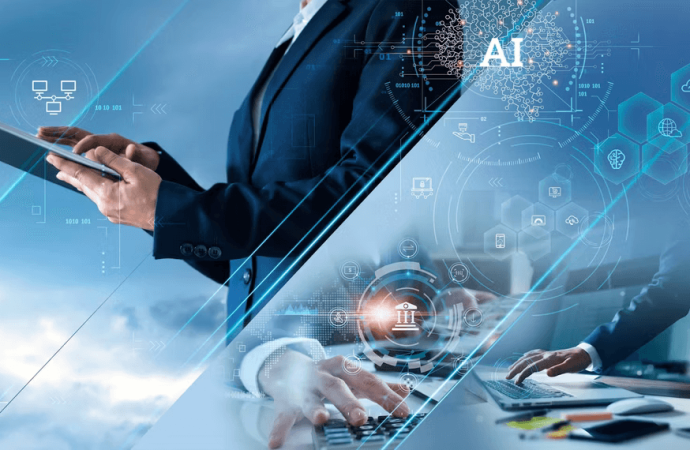Will AI or Blockchain Take Over the World First? While blockchain technologies gained traction during the peak of cryptocurrencies, they’ve recently taken a backseat to the AI race. Modern AI models disrupted the tech industry, with consumers, private businesses, government agencies, and tech developers incorporating AI into various sectors. 1. Long-Term Demand AI has yet
Will AI or Blockchain Take Over the World First?
While blockchain technologies gained traction during the peak of cryptocurrencies, they’ve recently taken a backseat to the AI race. Modern AI models disrupted the tech industry, with consumers, private businesses, government agencies, and tech developers incorporating AI into various sectors.
1. Long-Term Demand
AI has yet to realize even a fraction of its untapped potential. AI systems have been around since the 1900s but recently underwent radical changes. The emergence of modern models transformed the industry. Their ability to imitate natural language, generate lifelike visuals, and mimic human voices opened new opportunities for AI developers.
And there’s an infinite amount of data available for training. AI systems will grow more sophisticated as developers feed them broader datasets on various topics. In theory, they could integrate AI into any sector.
Blockchain is also an evolving technology that offers long-term usability, but its community must grow to achieve mass adoption. Otherwise, it won’t outperform mainstream digital storage and payment solutions.

Image by https://www.makeuseof.com/
2. Accessibility
AI has an edge over blockchain in terms of accessibility. Most people used AI systems before modern large language models (LLMs) launched. You’ll find it in everyday systems, like digital virtual assistants, facial recognition programs, chatbots, grammar checkers, and self-driving cars.
Most AI-driven platforms also have low barriers to entry. A simple, intuitive user interface (UI) design enables users of all levels to maximize powerful models. Take ChatGPT as an example. You can learn effective ChatGPT prompts for technical tasks, e.g., coding and site development, even if you barely understand how LLMs work.
Unfortunately, blockchain systems have a steep learning curve. They won’t replace mobile banking apps, data-sharing platforms, and digital storage systems until they adopt more intuitive UI designs.
3. Functionality
AI’s ability to mimic human-like capabilities features a broader scope of functions than blockchain. It performs programmed tasks, understands natural language, and forms justified conclusions. Sophisticated models could even finish complex projects that require human cognitive functions autonomously, e.g., driving and analyzing data.
And artificial general intelligence (AGI) is still decades away. AI will be able to do everything that people can once it achieves and exceeds human-level intelligence. It’ll transform how every industry operates.
Meanwhile, most use cases of blockchain revolve around data sharing/storage, which often underpin financial platforms. Various industries utilize blockchain systems to execute smart contracts, store confidential data, and maintain decentralized crypto transactions.

Image by https://www.makeuseof.com/
4. Public Perception
The ongoing AI race gives the general public a more positive perception of AI than blockchain. It’s an accessible system with infinite potential and a broad market. A longitudinal survey by Real Research even shows that 45 percent of consumers believe AI would drastically impact society. Only 35 percent of the same respondents are banking on blockchain technologies.
Although these results seem promising, some misconceptions exist about blockchain and AI systems. For instance, some consumers think blockchain and crypto are synonymous. Blockchain systems can execute smart contracts and transfer data securely, yet skeptics only focus on crypto scams.
Likewise, AI’s rapid expansion causes irrational fears. There are various myths about AI, ranging from subtle uncertainties to ridiculous theories like machines taking over the world.
5. Environmental Sustainability
Neither AI nor blockchain is inherently unsustainable, but deploying them consumes power. Let’s start with AI. A cost model by Semianalysis shows that ChatGPT needs 3,617 HGX A100 servers to answer prompts daily—running them 24/7 consumes 95,054.76 megawatt-hours per annum. Note that these figures still don’t include training costs.
Blockchain systems also consume massive energy resources. RMI states that running Bitcoin drains 127 terawatt-hours or 127,000,000 megawatt-hours per year. All that energy translates to millions of tons of carbon emissions.
Tech companies must make a proactive effort to minimize these technologies’ damaging ecological effects. They could even help better the environment. AI-integrated weather monitoring tackles climate change issues, while carbon offsetting enables blockchain systems to reduce their carbon footprint.

Image by https://www.makeuseof.com/
6. Cost
End users can access AI and blockchain through pre-built apps or Software as a Service (SaaS) products. You’ll find several affordable, or even free, options online. Just note that they’ll likely have fixed functions—you can’t integrate them into your applications or apply custom algorithms.
The cost of deploying blockchain and AI systems depends on varying factors. But for reference, it’s generally more expensive to train and maintain AI-driven platforms than to utilize custom blockchain systems. CNBC even reports that OpenAI likely spent $4 million training GPT-3. And while building on open-source LLMs cuts training expenses, long-term maintenance and system integration could still cost millions.
Deploying blockchain platforms often requires a smaller investment. PixelCrayons states that building a cryptocurrency basic exchange platform costs $50,000 to $$98,000, while a cryptocurrency wallet would cost around $15,000 to $150,000.
7. Regulation
Although decentralized systems give developers and end users more freedom, they also come with risks. Crooks can easily exploit unregulated systems. The lack of central governance with blockchain and AI already perpetuates various cybercrimes, from crypto rug pulls to AI-driven identity theft.
Both systems need some form of regulation. Centralized banks could manage crypto transactions by deploying blockchain platforms, and government bodies can start monitoring crooks exploiting AI. The only problem here is if they might compromise decentralization for security.

Image by https://www.makeuseof.com/
8. Support and Development
The ongoing AI race draws massive attention to AI systems. Developers, tech companies, end users, and business professionals continuously explore ways to utilize them. You’ll find modern language models integrated into various apps.
Blockchain technologies also impacted various sectors. However, with the rise of sophisticated AI apps and the proliferation of crypto scams, the general public is losing interest in them. Of course, tech companies will continue working on blockchain. It just might take some time before they overtake the accessibility and popularity of AI-driven platforms.
Will AI and Blockchain Technologies Cancel Out Each Other?
AI’s versatility makes it appealing to the general public, and blockchain has specific use cases within several niches. Both technologies could achieve mass adoption if they continue evolving. But more developers should explore AI-driven blockchains—integrating these platforms will yield better results than pitting them against each other.
Again, AI is a versatile platform with several applications. It will continue shaping modern technologies, so assess how it might affect your daily life. Utilize AI to your advantage and watch out for cybercriminals exploiting it.
Table: AI vs. Blockchain – Key Factors
| Factor | AI | Blockchain |
|---|---|---|
| Long-Term Demand | Growing rapidly | Evolving with community |
| Accessibility | Highly accessible | Steep learning curve |
| Functionality | Broad scope of functions | Limited use cases |
| Public Perception | Positive and promising | Misunderstandings exist |
| Sustainability | Energy-intensive | Energy-consuming |
| Cost | Expensive to train | Varied cost factors |
| Regulation | Requires monitoring | Need for governance |
| Support and Dev. | Continuous innovation | Losing public interest |
Comparative Table: AI vs. Blockchain Use Cases
| Use Case | AI | Blockchain |
|---|---|---|
| Finance | Algorithmic trading, fraud detection | Cryptocurrencies, smart contracts |
| Healthcare | Diagnostics, drug discovery | Medical records, supply chain tracking |
| Transport | Autonomous vehicles, route optimization | Supply chain transparency, logistics |
| Communication | Chatbots, language translation | Decentralized communication networks |
Audience: Problem Solvers
Whether you’re a tech-savvy individual or a business professional, understanding the future trajectory of AI and blockchain is crucial. Dive into the nuances of these technologies and gain insights into which one might achieve mass adoption first. With expert analysis and practical considerations, this article equips problem solvers with the knowledge needed to navigate the evolving tech landscape.

















Leave a Comment
Your email address will not be published. Required fields are marked with *